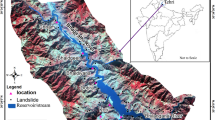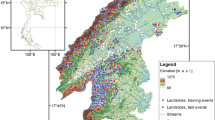Abstract
In India, the Bureau of Indian Standards (BIS) recommends a heuristic method for medium-scale (1:25,000/1:50,000) landslide susceptibility mapping. This is based on fixed ratings of geofactors, without the inclusion of landslide inventory information. In BIS method, the pre-defined ratings of geofactors are applied over diverse areas, irrespective of the terrain-specific spatial inter-dependence of geofactors and landslide types, which leads to rather moderate prediction. In this paper, we evaluate the effectiveness of the existing BIS method in Darjeeling Himalaya through a quantitative method adapting weights of evidence (WofE) modeling. The quantified spatial associations between specific geofactors for different landslide types and failure mechanisms that were generated, using this method showed improved prediction rates as compared to the BIS method of fixed ratings of geofactors. We therefore recommend adjusting the existing BIS guidelines by inclusions of weights, derived locally through quantitative spatial analysis of landslide inventories and geofactor maps.
Similar content being viewed by others
References
Anbalagan, R. (1992) Landslide hazard evaluation and zonation mapping in mountainous terrain. Engg. Geol., v.32(4), pp.269–277.
Bhattacharya, A., Mishra, P., Ghoshal, T.B., Bahuguna, H. and Ghatak, T. (1998) A geotechnical appraisal of landslides on 7th July, 1998 along National Highway No. 55. Geol. Surv. India, Progress Report.
BIS (1998) Preparation of landslide hazard zonation maps in mountainous terrains — Guidelines, Bureau of Indian Standards IS 14496 (Part — 2).
Bonham-Carter, G.F. (1994) Geographic Information Systems for Geoscientists: Modelling with GIS. Pergamon Press, Oxford.
Carranza, E.J.M. and Castro, O.T. (2006) Predicting laharinundation zones: case study in west Mount Pinatubo, Philippines. Natural Hazards, v.37(3), pp.331–372.
Carrara, A., Cardinali, M., Detti, R., Guzzetti, F., Pasqui, V. and Reichenbach, P. (1991) GIS techniques and statistical models in evaluating landslide hazard. Earth Surface Processes and Landforms, v.16(5), pp.427–445.
Chatterjee, B. (1983) A geological approach to the landslide hazard zonation in Darjeeling Himalaya. Geol. Surv. India, Progress Report (F.S. 1981-83).
Chung, C.J.F. and Fabbri, A.G., 1999. Probabilistic prediction models for landslide hazard mapping. Photogrammetric Engineering and Remote Sensing, 65(12): 1389–1399.
Chung, C.-J.F. and Fabbri, A.G. (2003), Validation of Spatial Prediction Models for Landslide Hazard Mapping. Natural Hazards, v.30(3), pp.451–472.
Ghoshal, T.B., Sarkar, N.K., Ghosh, S. and Surendranath, M. (2008) GIS based landslide susceptibility mapping — a study from Darjeeling-Kalimpong area, Eastern Himalaya, India. Jour. Geol. Soc. India, v.72, pp.763–773.
Sengupta, C.K. (1995) Detailed study of geofactors in selected hazard prone stretches along the surface communication routes in parts of Darjeeling and Sikkim Himalaya, Phase-I, Part-I (Rongtong-Kurseong road section). Geol. Surv. India, Progress Report (F.S. 1993-94).
Surendranath, M., Ghosh, S., Ghoshal, T.B. and Rajendran, N. (2008) Landslide hazard zonation in Darjeeling Himalayas: a case study on integration of IRS and SRTM Data. In: N. Sailesh. and S. Zlatanova (Eds.), Remote sensing and GIS technologies for monitoring and prediction of disasters. Environmental Science and Engineering, Springer, pp.121–135.
Hansen, A. (1984), Landslide hazard analysis. In: Brunsden and Prior (Eds.), Slope Instability. John Wiley & Sons, New York, pp.523–602.
Lu, P. and Rosenbaum, M.S. (2003) Artificial neural networks and grey systems for the prediction of slope stability. Natural Hazards, v.30(3), pp.383–398.
Mark, R.K. and Ellen, S.D. (1995) Statistical and simulation models for mapping debris-flow hazard. In: A. Carrara and F. Guzzetti (Eds.), Geographical Information Systems in Assessing Natural Hazards. Kluwer Academic Publishers, Dordrecht, pp.93–106.
Mathew, J., Jha, V.K. and Rawat, G.S. (2007) Weights of evidence modelling for landslide hazard zonation mapping in part of Bhagirathi valley, Uttarakhand. Curr. Sci., v.92, no.5, pp.628–638.
Soeters, R. and van Westen, C.J. (1996) Slope Instability: Recognition, analysis and zonation. In: A.K. Turner and R.L. Schuster (Eds.), Landslide: Investigations and Mitigation. Special Report 247. Transportation Research Board. National Research Council. National Academy Press, Washington DC, pp.129–177.
Surendranath, M., Ghosh, S., Ghoshal, T.B. and Rajendran, N. (2008) Landslide hazard zonation in Darjeeling Himalayas: a case study on integration of IRS and SRTM Data. In: N. Sailesh and S. Zlatanova (Eds.), Remote sensing and GIS technologies for monitoring and prediction of disasters. Environmental Science and Engineering, Springer, pp.121–135.
Van Westen, C. J. (1993) GISSIZ: training package for Geographic Information Systems in slope instability zonation: Part 1. theory, ITC Publication No. 15, ITC, The Netherlands
Van Westen, C. J. (2000) The modelling of landslide hazards using GIS. Surveys in Geophysics, v.21, pp.241–255.
Varnes, D.J. (2000) Landslide Hazard Zonation: a review of principles and practice. UNESCO, Darantiere, Paris, pp.61.
Yin, K.L. and Yan, T.Z. (1988) Statistical prediction models for slope instability of metamorphosed rocks. In: C.H. Bonnard (Ed.), Proceedings of the 5th International Symposium on Landslides, vol. 2, Balkema, Rotterdam, pp.1269–1272.
Author information
Authors and Affiliations
Corresponding author
Rights and permissions
About this article
Cite this article
Ghosh, S., van Westen, C.J., Carranza, E.J.M. et al. A quantitative approach for improving the BIS (Indian) method of medium-scale landslide susceptibility. J Geol Soc India 74, 625–638 (2009). https://doi.org/10.1007/s12594-009-0167-9
Received:
Accepted:
Published:
Issue Date:
DOI: https://doi.org/10.1007/s12594-009-0167-9




